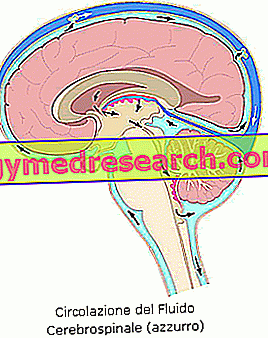Definition of liquor
The liquor is a clear and colorless fluid that permeates the central nervous system, protecting the brain and spinal cord from possible trauma.

Liquor Circle
The liquor is produced inside the cerebral ventricles, precisely at the level of the choroid plexuses (formed by specialized ependymal cells). Circulating along the brain ventricles, the liquor reaches the sub arachnoid space, the area between the pia mater and the arachnoid of brain and spinal cord. Let us remember briefly that the arachnoid and the pia mater (leptomeninge), together with the dura mater (pachimeninge), envelop the CNS and the initial nerve tract.
The cerebrospinal fluid, which flows in a caudal direction, is absorbed by the arachnoid villi (trabeculae that branch out from the arachnoid), subsequently poured into the venous sinuses.
Cerebral ventricles → choroid plexus (production of CSF) → sub arachnoid space between arachnoid and pia mater → arachnoid villi → discharge of CSF in venous sinuses
Functions
The liquor fulfills several, very important, functions:
- Protects the brain and spinal cord from injury. In textbooks it is not uncommon to find the expression "the brain floats in the liquor" or "the liquor acts as a cushion for the brain". These two sentences, at first glance absurd, are metaphors that best express the main function performed by the cerebrospinal fluid: to protect the CNS from impacts or traumas against the bony structures that contain it. The brain weighs approximately 1, 300-1, 400 grams; however, floating in the liquor (thus receiving an Archimedean push) the brain has an "effective" weight of 25-50 grams.
- It nourishes the CNS: the liquor is the vehicle to distribute the nutrients in the central nervous system. In other words, the cerebrospinal fluid participates in the exchange of metabolites and nutrients between brain and blood.
- Contributes to the regulation of intra-cranial pressure and prevents cerebral ischemia. Indeed, the liquor adjusts its volume to changes in blood flow and brain mass: in doing so, it maintains both the pressure and the intracranial volume constant.
Chemical composition
The analysis of the liquor provides relevant indications on the general state of health of the CNS: the alteration of the chemical characteristics of the liquor is often synonymous with disease / infection in progress.
A sample of cerebrospinal fluid can be collected using rachicentesi (or lumbar puncture), a surgical strategy that involves inserting a needle between the third / fourth or fourth / fifth lumbar vertebra. Once the subarachnoid space is reached, a sample of liquor is collected.
Although derived from blood by a complex ultrafiltration mechanism, the liquor has a completely different chemical composition from that of plasma.
Water, oxygen and carbon dioxide flow easily from the blood to the liquor through passive diffusion, through the membranes, while some ions (magnesium, chlorine, calcium, bicarbonate, sodium, potassium) arrive in the liquor with extreme difficulty.
To assess the integrity or impairment of the CNS, the liquor is analyzed in its different qualitative and quantitative aspects. The main parameters analyzed in the liquor are: color, cell count, glucose and protein levels, presence of antibodies and pathogens.
Healthy liquor
Below are the main characteristics of a healthy liquor: an eventual alteration is often synonymous with pathology or infection in progress.
Parameters analyzed | Reference interval for a healthy liquor |
ASPECT AND CHROMY | Transparent, defined rock water (or rock) |
CHLORIDE (Clorurorrachia) | 700-750 mg / dl or 115-130 mEq / L |
WHITE BLOOD CELLS | <5 / mm3 (all mononuclear) |
RED BLOOD CELLS | 0 |
GLUCOSE (glycorrachia) | 50-80 mg / dL (equivalent to 2/3 of the blood sugar) |
Glutamine | 6-15 mg / mL |
LACTATE | 10-40 mg / dL in newborns 10-25 mg / dL in older children and adults |
| DEHYDROGENASE LACTATE (LDH: enzyme that catalyzes the interconversion of lactate to pyruvate) | Between 2.0 and 7.2 U / mL |
pH | Including in the range of 7.28-7.32 |
LIQUOR PRESSURE |
|
| TOTAL PROTEINS (proteinorrachia) | 15-45 mg / dL. In some cases, even a proteinorrachia of 60 mg / dL is acceptable |
Clearly, the absence of pathogens and tumor cells in the CSF is also indicative of a healthy liquor.
Altered liquor
The variation of the normal qualitative and quantitative parameters of the liquor, shown in the table, must immediately alert. The rachicentesi is an exceptional diagnostic strategy, which allows the collection of a CSF sample: the subsequent analysis of the CSF offers a general picture of the degree of CNS integrity.
What are the possible morbid conditions associated with an ANOMALO LIQUOR?
The most frequent diseases detectable by liquor analysis are:
- Infections: encephalitis, meningitis
- Autoimmune diseases: meningeal sarcoidosis, multiple sclerosis, Guillan-Barrè syndrome
- Neoplasms of the CNS
What does a DECREASE OF GLUCOSE in liquor symbolize?
The decrease in glycorrachy is a lit indicator of:
- Hemorrhage (or hematoma) sub arachnoid
- Hypoglycemia
- Bacterial or fungal meningitis
- Meningeal metastases
- Tuberculosis
What pathological significance does a liquor rich in leukocytes (LEUCOCYTOSIS) take on?
Detection of reactive leukocytosis in the CSF may indicate:
- Parasitic infections
- Meningitis
- Meningoencephalitis (from heartworm)
- Polineurite (inflammatory process that involves multiple nerves simultaneously)
- Meningeal sarcoidosis
- Multiple sclerosis
- Guillain-Barrè syndrome
What diseases can be hidden behind an increase in polymorphic nucleated NEUTRROPHILES in liquor?
- Brain abscess
- Convulsions
- hemorrhage
- Subdural empyema (discharge of blood into the space between the arachnoid and dura mater)
- Encephalitis
- Bacterial / viral / fungal / tuberculous meningitis
- Neoplasms
What diseases can be suspected when MONOCYTISIS (increase in the number of monocytes) in liquor is revealed ?
- Intracranial hemorrhage
- Cerebral infarction
- Syphilitic / viral / fungal / bacterial meningitis
- Neoplasms
What can hide a REDUCED concentration of LACTATE in liquor?
A reduction in the concentration of lactate in the liquor is an indicator light of pathologies such as:
- Cerebral atherosclerosis
- Colon cancer (late stage, metastasis)
- Convulsions
- Intracranial hemorrhage → also the increase of lactate dehydrogenase (LDH) in liquor is a spy of intracranial hemorrhage
- Hypotension
- Injury / trauma
- Bacterial meningitis (species from mycoplasma ) → further confirmation of meningitis is obtained by increasing the LDH in the liquor



